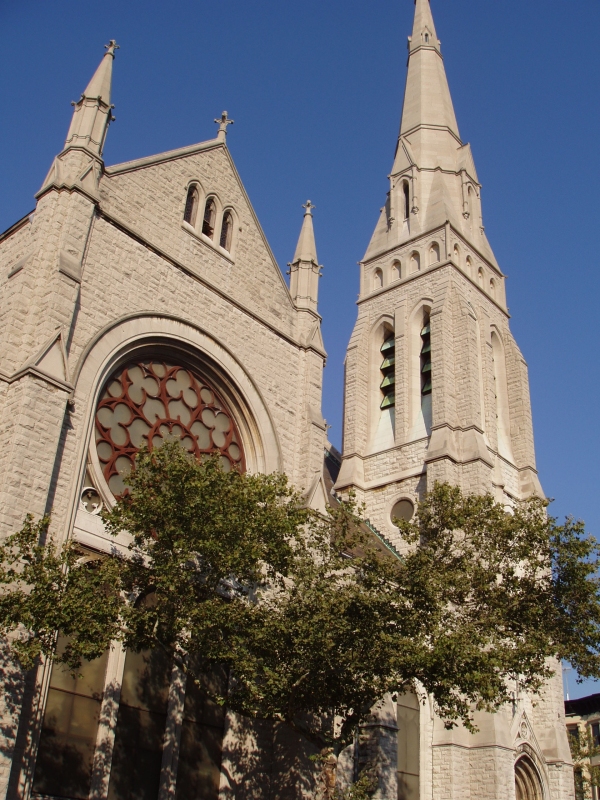 Like many other Baby Boomer believers who grew up in the era of ugly-as-sin church architecture, I am a total sucker for stately, soaring old churches.
Several years ago, I walked around during my first ever visit to Rome and found myself asking one question over and over: With all of these secular Italians declining to have children, who is going to fill or maintain all these gorgeous churches? I'm not talking about St. Peter's and the famous sanctuaries, of course. I am talking about the churches you find gracing every other block of that increasingly post-Christian metropolis.
Like many other Baby Boomer believers who grew up in the era of ugly-as-sin church architecture, I am a total sucker for stately, soaring old churches.
Several years ago, I walked around during my first ever visit to Rome and found myself asking one question over and over: With all of these secular Italians declining to have children, who is going to fill or maintain all these gorgeous churches? I'm not talking about St. Peter's and the famous sanctuaries, of course. I am talking about the churches you find gracing every other block of that increasingly post-Christian metropolis.
This story has an American connection, of course, one that is linked to demographics and the rise and fall of the mainstream American churches in the age of suburban megachurches (which are beginning to show signs of age, as well). How does one tell the story of the rise of the new Religious Right in recent decades without paying close attention to the factors that fueled the fall of the old religious mainstream, the demographic implosion of what is now the Religious Left?
And who is going to fill and maintain all of those gorgeous old mainline churches in the hearts of America's great old cities?
This is what I kept thinking as I read this Wall Street Journal report about the efforts to rescue the Old First Reformed Church in Brooklyn. The roof, you see, is literally falling. A large chunk of plaster fell into the pews last year during a service being held by a liberal Jewish congregation that was using the sanctuary.
This sets up the new facts of life:
Now, Rev. Meeter and other church leaders are scrambling to raise approximately $700,000 to replace the ceiling. The church in the center of Park Slope has received small grants from conservation groups and will likely have to take out a sizable loan to fund the renovation.
The predicament faced by Old First, as members call it, and the church's strategy for dealing with the problem, mirrors that faced by hundreds of houses of worship in New York and elsewhere, as donors pull back amid a tough economy, membership rolls shrink and churches and temples turn to other uses of their space to keep them vibrant and help pay the bills.
Some historically important and even breathtaking works of religious architecture are in danger of being forgotten, and are turning to unconventional means to mobilize the support they need to make capital investments.
That covers all the bases. The problem with the story is that it is, literally, haunted by all of those empty pews and the people who once worshiped in them, week after week. What happened to them? The driving force in this story is not gravity, it's those shrinking membership rolls.
This is, alas, never addressed in any meaningful way in this story. The plight of the physical sanctuary is the heart of the story and I get that. But why is all of this happening? Why is the Cathedral Church of St. John the Divine having to sell land to real-estate directors? New York City is in the midst of a religious revival, in some quarters. Which churches are trying to fill empty pews, while other are seeking additional pews (and school buildings, even) they can fill?
The closest readers come to knowing anything about the church, by which I mean the people, as opposed to the church building is one crucial fact in this following summary:
Built in 1891 out of limestone and granite, Old First was the only church known to have been designed by architect George L. Morse, who built several important turn-of-the-century office buildings, including the Temple Bar building, in downtown Brooklyn. The church's fixtures are done in ornately carved woods painted in warm browns and salmon colors, and its high roof creates a solemn, eerie spaces for the light that filters through its Tiffany windows. The church is truly an urban cathedral -- stately and formal, but at the same time warm and womb-like.
The church follows a square-shaped Basilica plan, rather than the long, rectilinear form of most cathedrals, and has a 200-foot steeple, a soaring, arched ceiling, a grand neo-Gothic stone entranceway, and a collection of nationally known stained-glass windows depicting biblical parables.
The congregation, which was established in 1654 by New York's last Dutch governor, Peter Stuyvesant, is one of the city's oldest. But in the last few years, the church's membership has dwindled to just 150 -- the church itself has seating for 1,200 people.
What are the trends in the congregation? Maybe we could have one paragraph on that essential information, since the building simply cannot survive without people? What is the Reformed Church in America? How is the denomination doing these days?
Again, I know that the building is THE STORY. I get that.
But the doctrinal and demographic forces pulling at the church are linked to the life and future of this congregation and, thus, the fate of the sanctuary itself. Might the religion element of the story -- the ghosts in those empty pews -- deserve a few sentences? Maybe even a paragraph or two?
